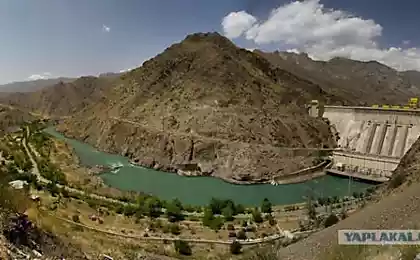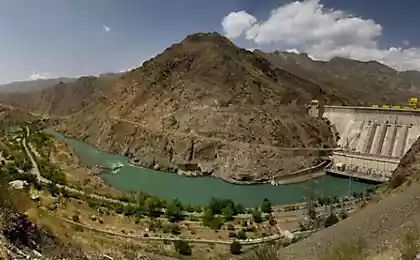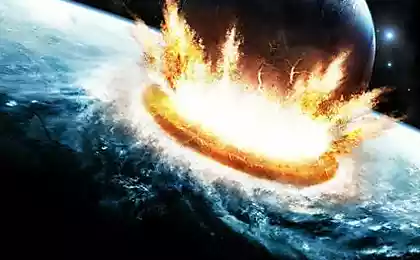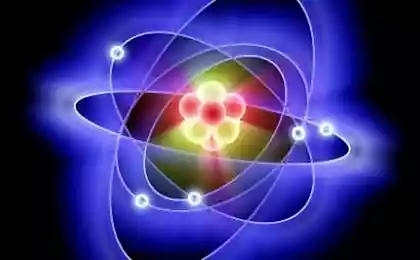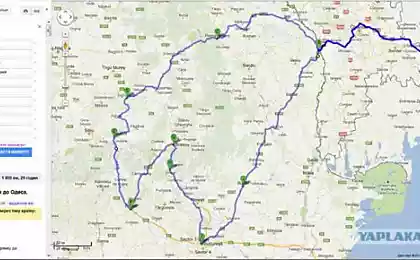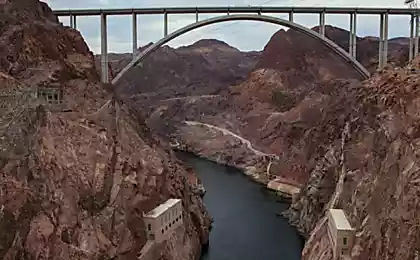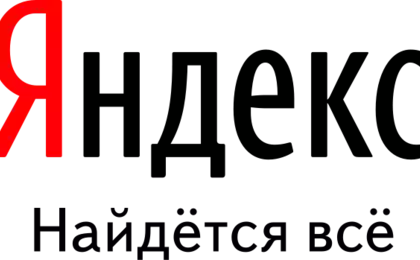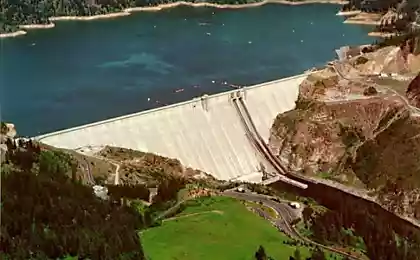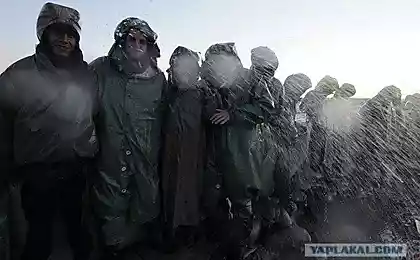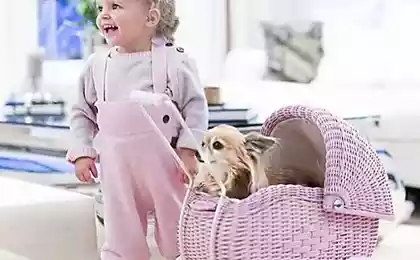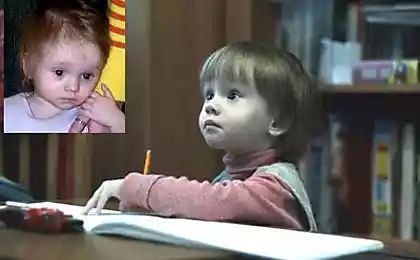1106
Croton Dam - the engineering wonder of the world
In New York, a lot of attractions that can surprise even the most experienced traveler, but this place is somehow struck me the most. Surprisingly, it was not one of the famous New York skyscrapers and bridges, and in general, this structure is located outside the city, although it is part of his livelihood. It is a real engineering marvel created by human hands at the turn of the 19th and 20th centuries, the type and extent of which is breathtaking.
46 photos via samsebeskazal

Amazing Croton system is already more than a hundred years, it provides New Yorkers with clean drinking water. Water supply system, which radically changed the life in the city has helped get rid of the dirt on the streets, win numerous fires and epidemics, and to improve the quality of life of its citizens. Today I will talk about Croton Dam, which is 35 km away. north of the city, and once was one of the key elements of this system. Without it the rest of the construction would be impossible, and New York would never thus the city as we know it now.
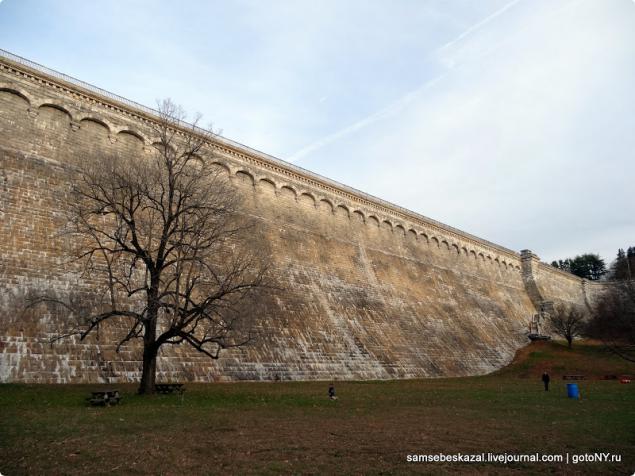
The first structure to supply New York City clean water was the dam, is now called the Old Krotonsokoy. Its construction lasted from 1837 to 1842, and it was the first masonry dam built in the United States. By 1881, after numerous repairs and dodelok dam delivered to New York 340 000 cubic meters of water daily. Water was in town on a specially built underground Croton aqueduct stretching 66 kilometers, which will be a separate post. In 1885, due to the dramatically increased needs of the city with clean water, a special city commission makes a decision on construction of a new drainage facilities in the same area, and to deliver it to build another aqueduct. According to the developed project in the 6, 5 km downstream of Croton to be built a new dam, resulting in the construction of which formed a vast reservoir, and the water supply of the city will increase to 1 million. Cubic meters per day.
3. Croton River before and after construction of the dam. Illustration from Scientific American magazine in 1891. The old dam fell into the flood zone and now the water is visible only the upper part of it.
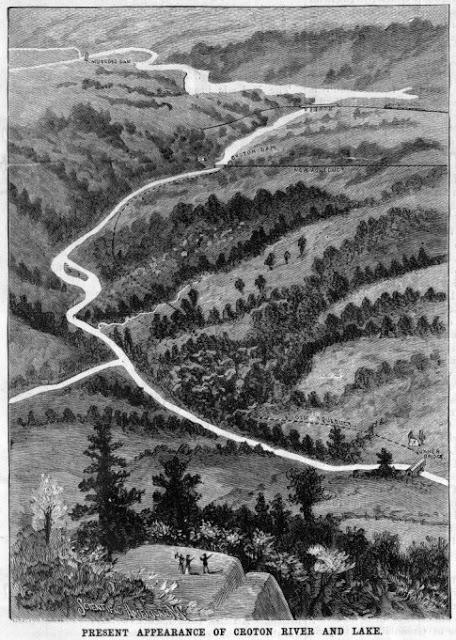
He won the tender for the construction of James Coleman, head of the Department of cleaning the streets of New York, who had extensive experience in the construction of roads and tunnels. The then law does not prohibit the state to combine fasting and self-employed business, even if the commercial interests in this matter were fairly obvious. Under the contract, he undertook to build a dam for five years, for which he received from the city budget a fantastic sum for those times at 4,150,573 dollars. Initially, the project involved the construction of a dam for another two kilometers below, close to the current town of Croton-on-Hudson, where the rock almost comes close to the surface, but the project has caused a wave of indignation and protests of local residents, we had to move it higher. In the flood zone of the reservoir fell about 50 square kilometers of land, on which were placed many homes, farms, schools, churches and cemeteries. After a long and dreary land acquisition procedures, which were accompanied by countless irregularities scandals and court proceedings, after the relocation of people and transfer of housing, and even the dead from cemeteries, work finally began in 1892.
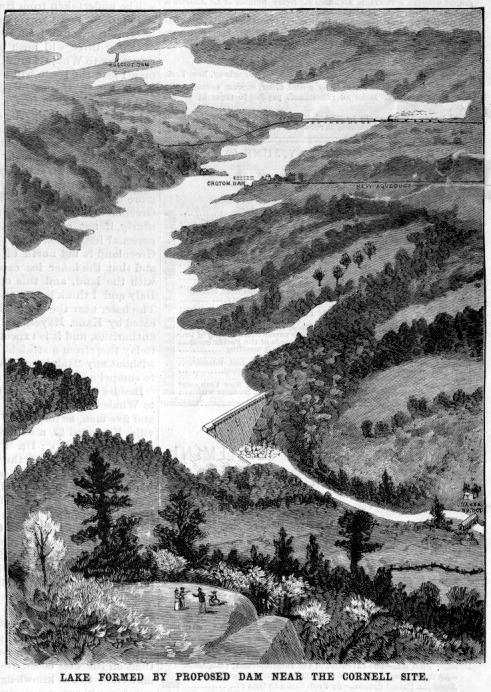
The chief engineer of the project was a little-known then and now Alphonse Feley. They were designed quite unique for its time structure, which is even more than a hundred years later, is striking in its scale and design. One can only imagine what was the reaction of his contemporaries, because at the time of construction of New Croton Dam is the highest in the world, was the world's largest structure made of stone and was the third largest structure on earth built by human hands, after the Great Wall of China and the Pyramids. < br />
5. Comparison of the New Croton dam building with Fuller Building, now known as the Iron. The white line shows the construction of the foundation.
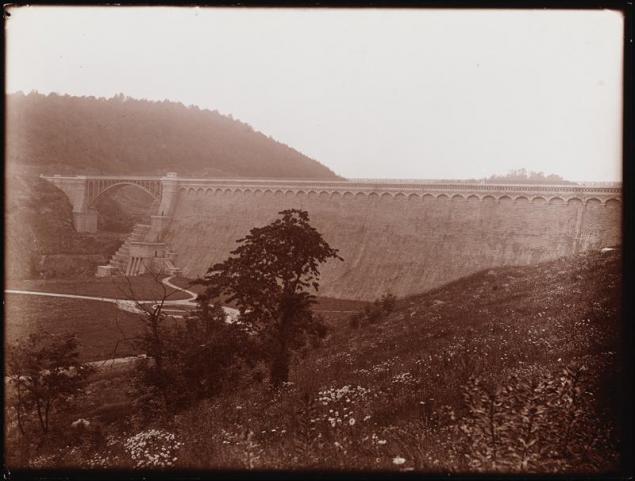
The new location was not so well from an engineering point of view, as selected initially, and there had to solve many problems, including digging a huge pit depth of 40 meters to reach the rock on which it was possible to start construction of the foundation. The dam is built on the technology of masonry, the volume of which is 650 000 cubic meters. Stones connected by cement mortar.
6.
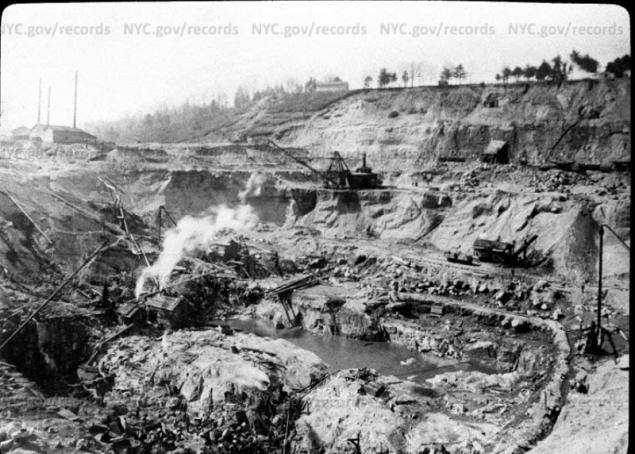
The material was used granite, which is mined in quarries near Hanterbrukom, and then delivered to the construction site on specially built rail branches. On the construction site itself was built a miniature railway, which went on steam shovel on a small train transports chosen breed and brought the stones.
7. photo by NYC Municipal archive

8. Massive blocks weighing 2 tons each moved by a crane erected on the principle of cableway. To close the steam was specially built a small plant for its production.
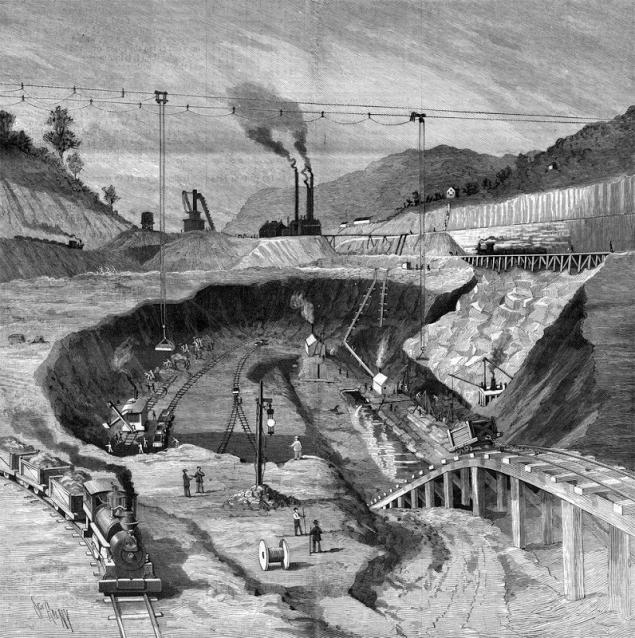
Another unique solution was the construction of spillway, which was risky to equip in the middle of the dam because of the risk of its destruction. The capacity of the spillway is not regulated and depends on the water level in the reservoir. Masonry is not as reliable as concrete, it may simply erode with increasing water pressure. Extensive experience in creating such facilities did not exist and had to invent a lot of things on the go. Feley chose an elegant and original solution, which gives such an unusual view of the dam. Weir was placed in the left part, and for its arrangement was correctly used terrain and drop at this point. It turned out something like a small channel beginning near the water surface and increases its depth as it approaches the wall of the dam. It was he who gave the effect of refraction, which was in the photo of my post issue. This solution will reduce the load on the structure, especially during floods, or in the case of a sharp increase in water level in the reservoir. Time has shown that this solution was chosen and performed brilliantly.
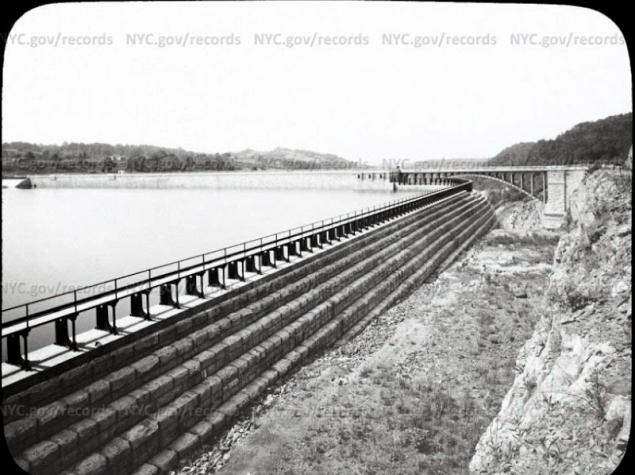
Another is its unique solution was to attract teams masons from southern Italy. They were taken by boat to New York, where they were given $ 25 in hand to disembark (without the money they would simply not allowed in America). Around the corner, they took money from them, masons themselves put on a train and sent to the construction site, where he settled in specially constructed for them to barracks. In America simply could not find the necessary number of specialists for the construction of such a large building.
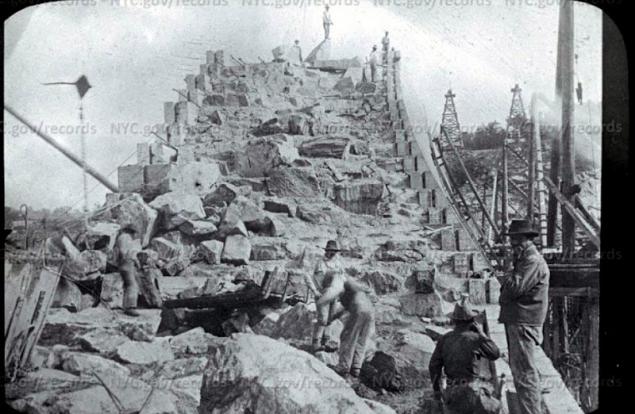
And the Italians are less expensive that reduces costs and increases profits. During the 10-hour working day, heavy physical work, they received $ 1 30 cents, while the typical American worker received 22 cents per hour. Harsh working conditions and low wages led to a strike in April 1900. As a result, the payment rose slightly, the strike itself was suppressed with the help of the cavalry, and its organizers arrested and prosecuted. For these events even made a black-and-white silent film called «The Croton Dam Strike».

12
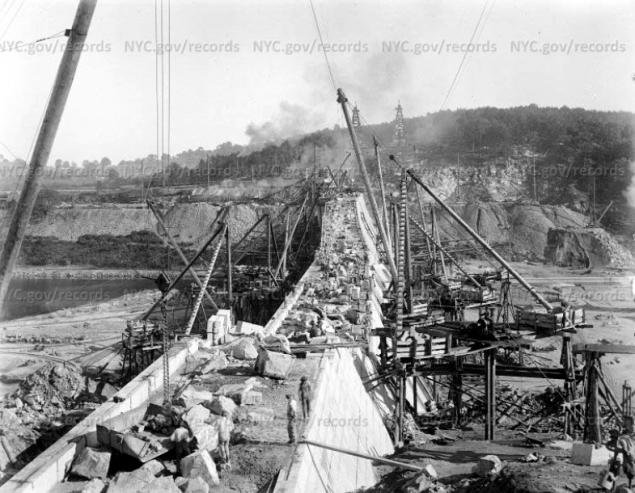
13
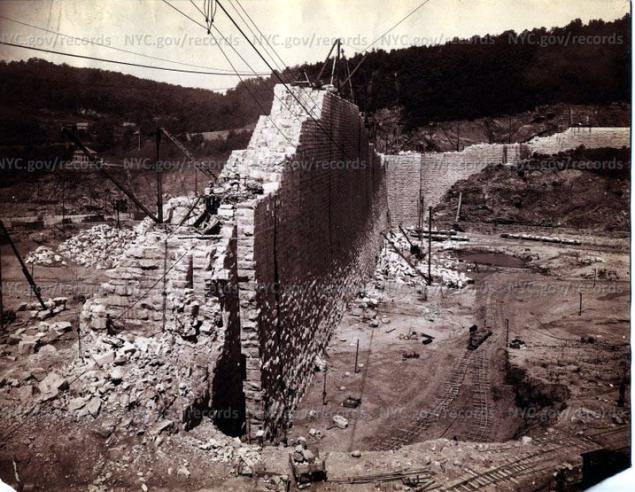
14
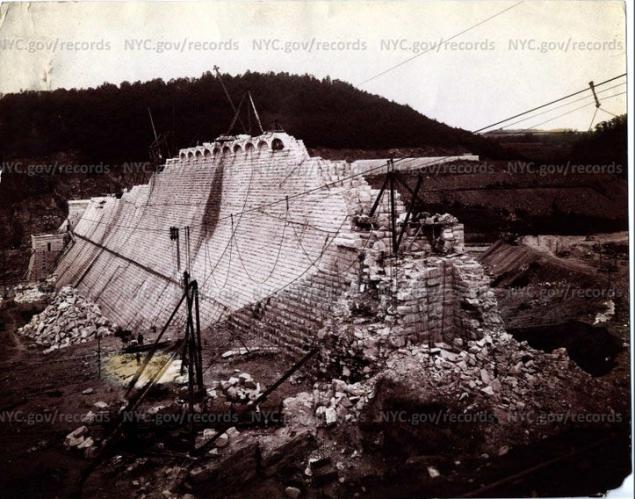
15
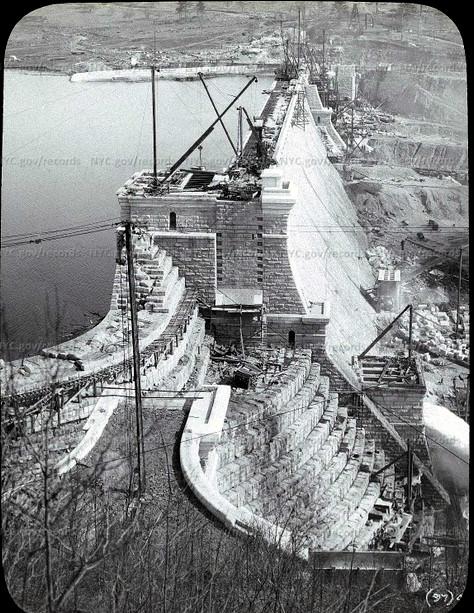
16. The territory of future flooding.
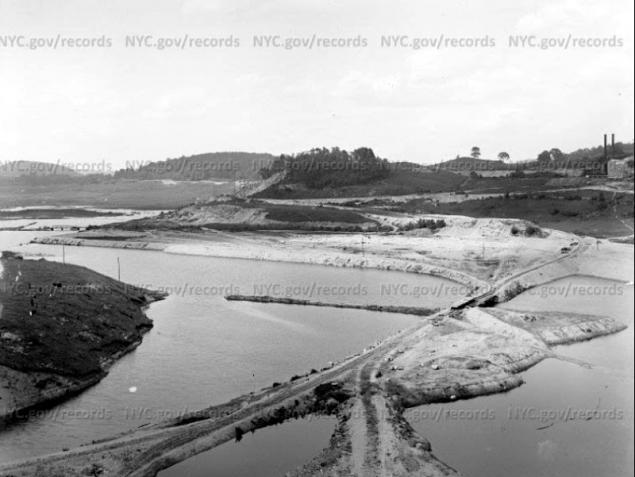
Construction of the dam required a change in the river bed and the draining of its old bed. For this was dug a bypass channel length of 300 meters and a width of 61 in the form of a crescent, the ends of which were part of the old channel. Places for its construction was not enough and had to bite into the rock with northern The sides of the future dam. When laying channel was undeveloped defensive wall, and several dams to control the water level. The work continued day and night throughout the year and were stopped only a few times during a very severe frosts. In winter time blocks treated with steam and was added to a solution of salt. The main construction work took 8 years. Six took numerous modifications, debugging and maintenance. Officially, the dam was completed in 1906. In fact, it reinforced and improved for many years. The final cost of its construction amounted to 7.7 million dollars.
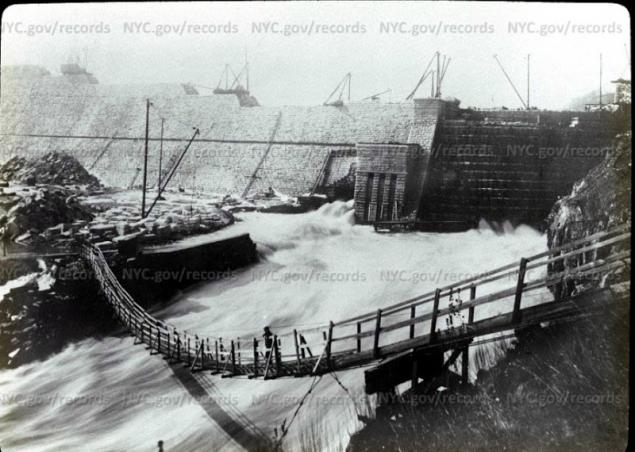
In those days, even the beauty and grace of the specific structures as dams were valued no less, and perhaps even more than its functionality. Any such object automatically became a place of attraction for tourists from all over the country and had to meet the requirements of the most picky audience that flocked in large numbers to see the latest achievements of engineering thought to sitting in the noise and splash of falling water to reflect the imminent triumph of progress. News about the construction did not descend from newspaper editorials, and detailed diagrams depicting device dam graced the pages of specialized magazines. Therefore, the dam is unique not just from an engineering point of view, but also just beautiful. It was intended to symbolize the achievements of North American states around the world, and to show that the Americans are able to solve problems of any complexity. People just barely harnessed steam engine, did not really have the production equipment and machinery, and were ready to put the river back. The magazine Scientific American wrote in 1905 - "the noble structure will be one of the most impressive and beautiful engineering solutions, and will testify to our achievements throughout the world."
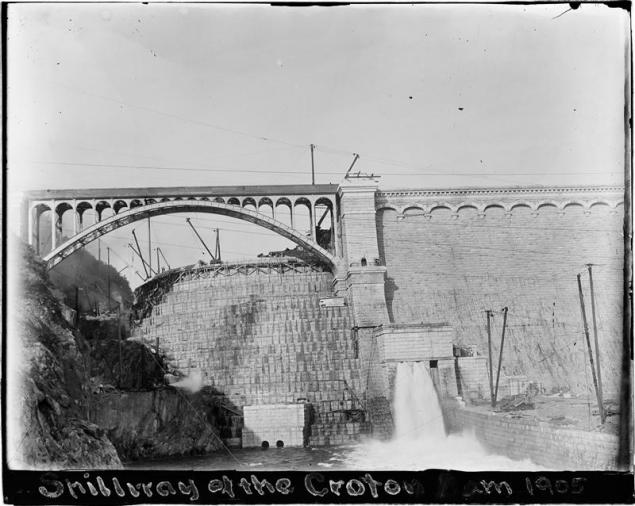
19
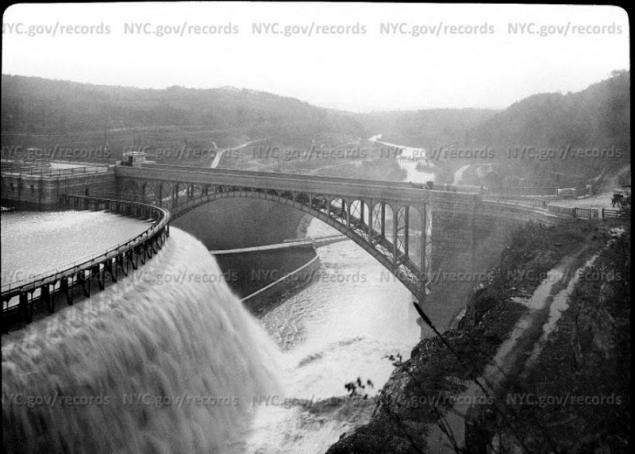
20. The dam has a height of 91 meters from the base to the crest. The total length of a weir is 667 meters.
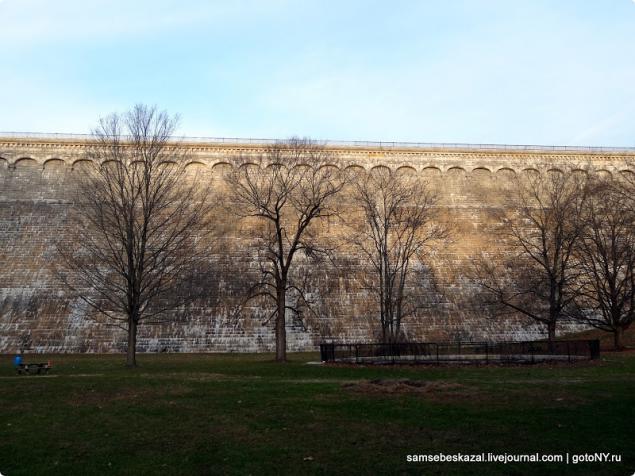
21. Before it is not acting now fountain.
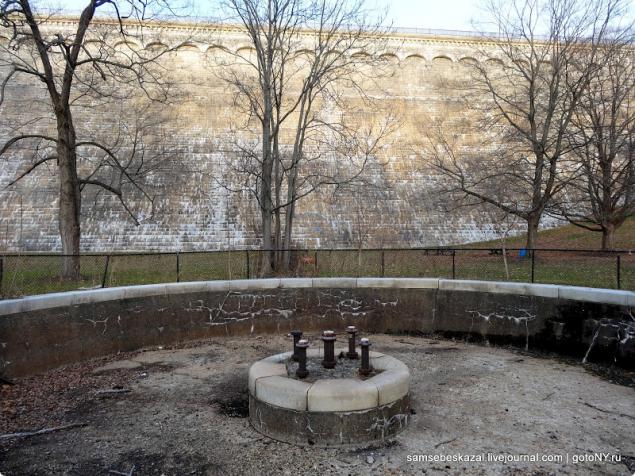
22
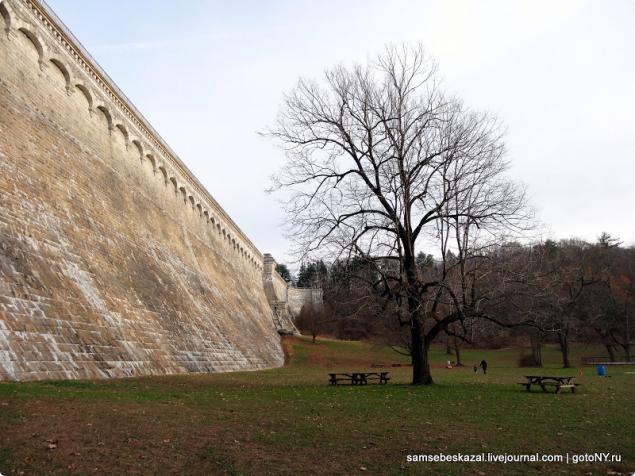
23. One of the two stairways leading inwards.
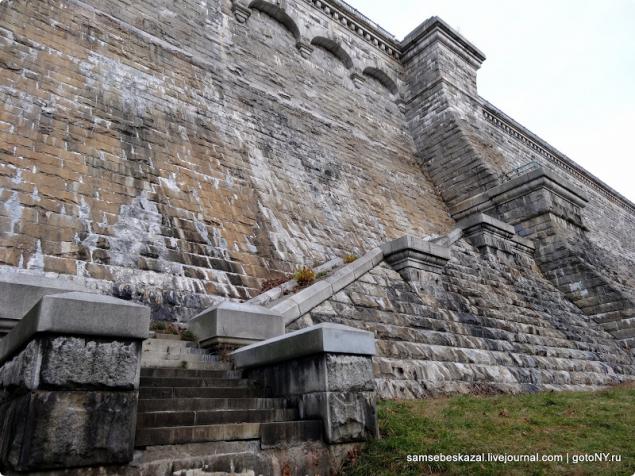
24. All the doors are securely walled.
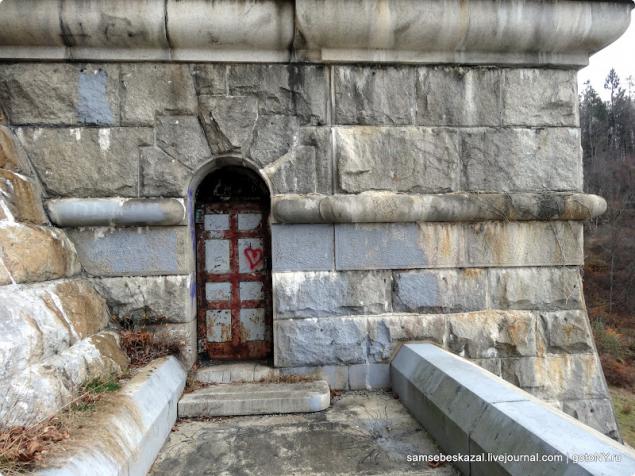
25. When I try to see what's inside, he saw only the old beer cans and bottles.
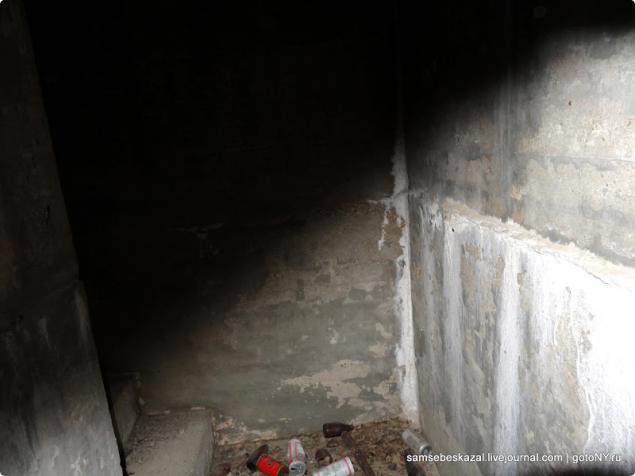
26. The dam periodically gives minor leaks. White traces of it drips from the solution are sitting on rocks.

27
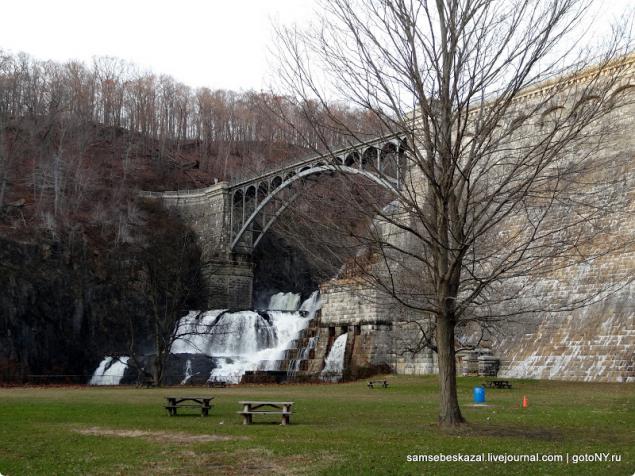
28. Weir.
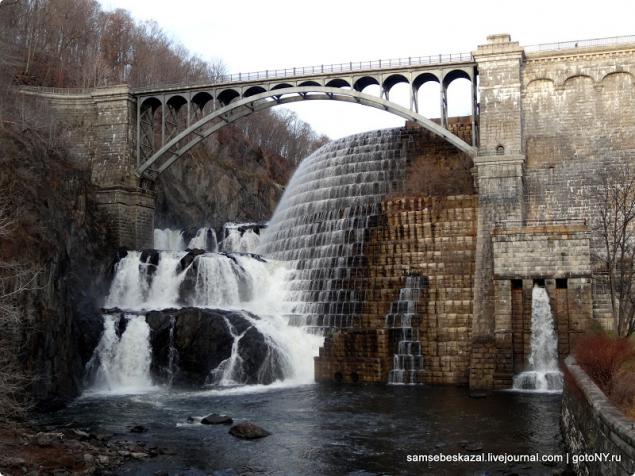
29
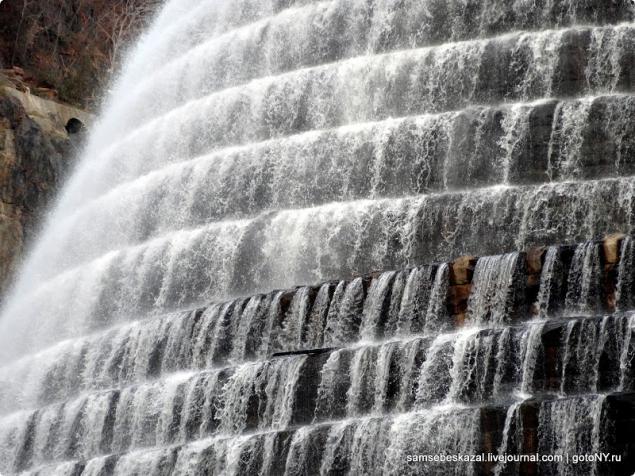
30. Right before the dam is a bridge which is convenient to take pictures.

31. The view down the river.
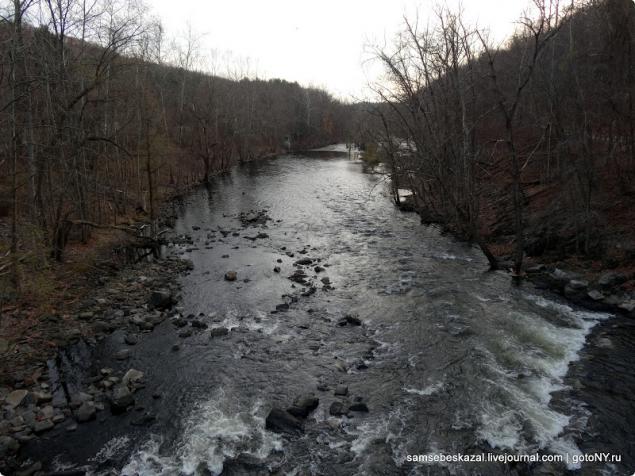
32. On the crest passes road, on which the movement was limited after the tragedy of September 11th. Now it is occasionally used cars of special services and the few tourists who come here for a walk.
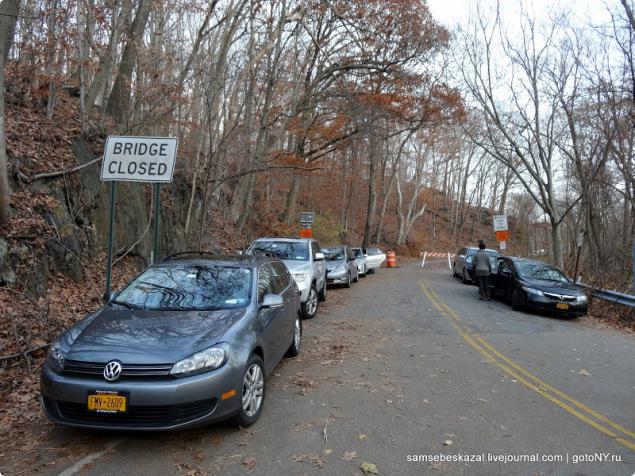
33
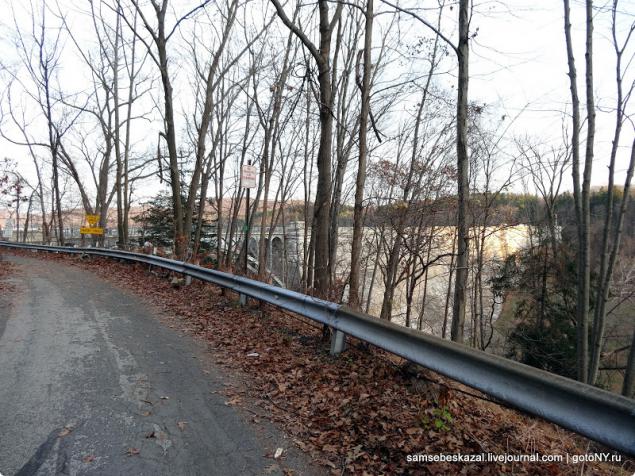
34
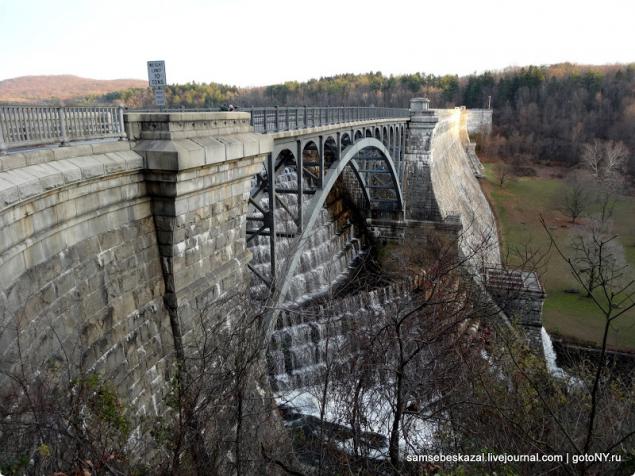
35. Entry into the dam.
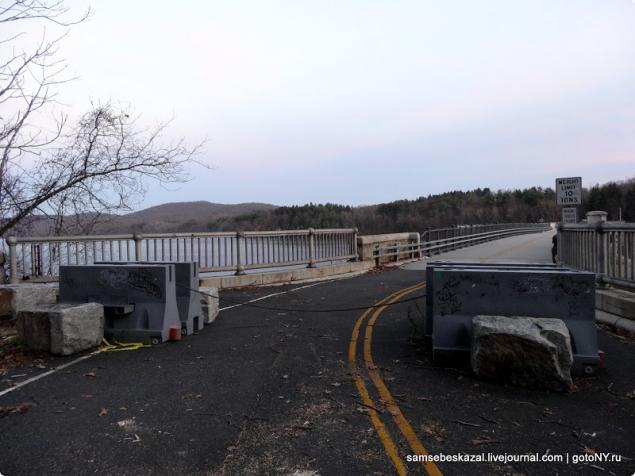
36. Weir pretending a little unreal.

37. The view down.

38. The road running along the dam.

39. The entrance to the utility room.
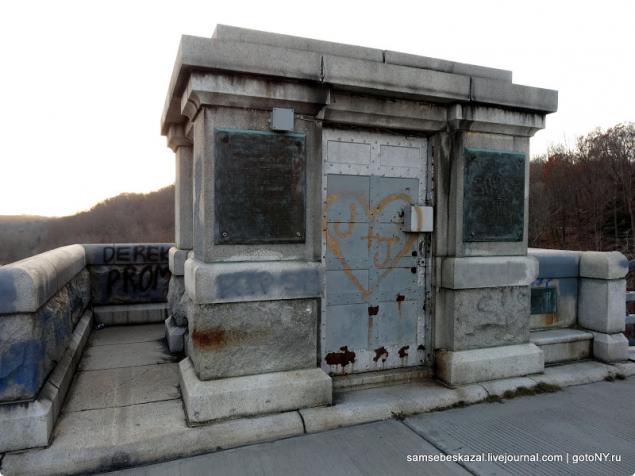
40. Metal bridge several times overhaul. The last time was in 2005.
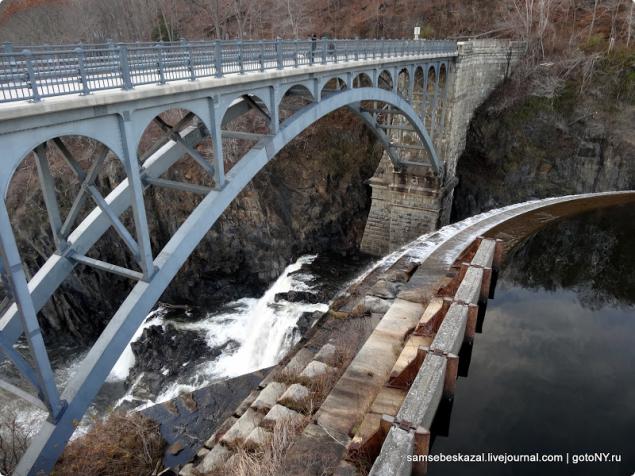
41
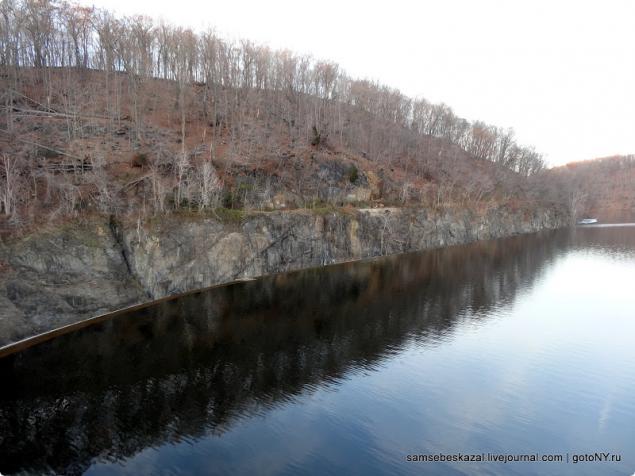
42

43. Reservoir.
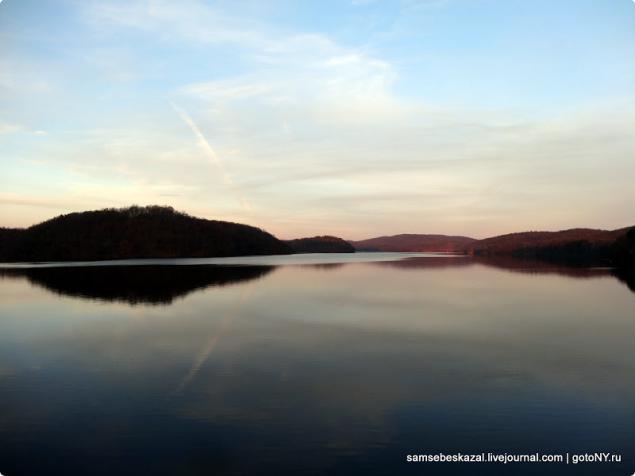
44
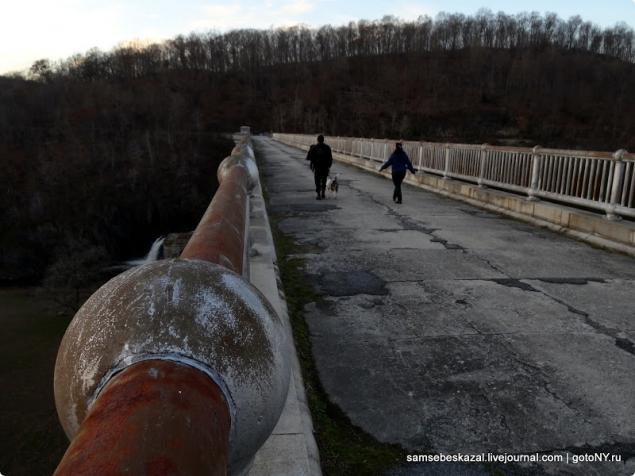
45. The entrance to the dam from the other side.
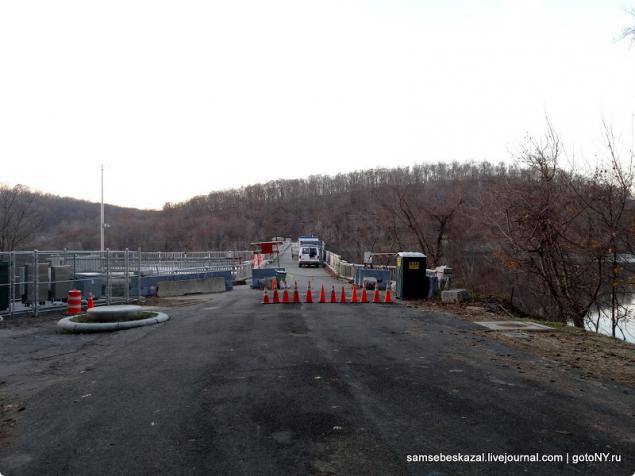
46. The water in the reservoir.
Posted in [mergetime] 1363347194 [/ mergetime]
New Croton jokingly considered a mixture of Niagara Falls from the Hoover Dam. And she did wonderfully combines the properties and external features of these two truly amazing facilities, only a few reduced scale. Another feature of the dam is its insufficient popularity as a tourist destination. Despite the proximity to the city, vistas and unique structures of the Croton Dam know not all New Yorkers. I'm pretty sure that some of my New York readers have never even heard of it, although it is less than an hour from Manhattan. It's hard to say why it happened, but the fact remains that very many have yet to discover the current monument of engineering from the early 20th century.
Video for completeness.
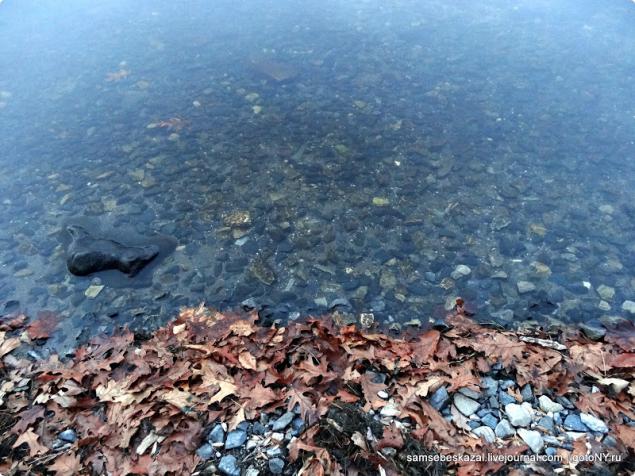
Source:
46 photos via samsebeskazal

Amazing Croton system is already more than a hundred years, it provides New Yorkers with clean drinking water. Water supply system, which radically changed the life in the city has helped get rid of the dirt on the streets, win numerous fires and epidemics, and to improve the quality of life of its citizens. Today I will talk about Croton Dam, which is 35 km away. north of the city, and once was one of the key elements of this system. Without it the rest of the construction would be impossible, and New York would never thus the city as we know it now.

The first structure to supply New York City clean water was the dam, is now called the Old Krotonsokoy. Its construction lasted from 1837 to 1842, and it was the first masonry dam built in the United States. By 1881, after numerous repairs and dodelok dam delivered to New York 340 000 cubic meters of water daily. Water was in town on a specially built underground Croton aqueduct stretching 66 kilometers, which will be a separate post. In 1885, due to the dramatically increased needs of the city with clean water, a special city commission makes a decision on construction of a new drainage facilities in the same area, and to deliver it to build another aqueduct. According to the developed project in the 6, 5 km downstream of Croton to be built a new dam, resulting in the construction of which formed a vast reservoir, and the water supply of the city will increase to 1 million. Cubic meters per day.
3. Croton River before and after construction of the dam. Illustration from Scientific American magazine in 1891. The old dam fell into the flood zone and now the water is visible only the upper part of it.

He won the tender for the construction of James Coleman, head of the Department of cleaning the streets of New York, who had extensive experience in the construction of roads and tunnels. The then law does not prohibit the state to combine fasting and self-employed business, even if the commercial interests in this matter were fairly obvious. Under the contract, he undertook to build a dam for five years, for which he received from the city budget a fantastic sum for those times at 4,150,573 dollars. Initially, the project involved the construction of a dam for another two kilometers below, close to the current town of Croton-on-Hudson, where the rock almost comes close to the surface, but the project has caused a wave of indignation and protests of local residents, we had to move it higher. In the flood zone of the reservoir fell about 50 square kilometers of land, on which were placed many homes, farms, schools, churches and cemeteries. After a long and dreary land acquisition procedures, which were accompanied by countless irregularities scandals and court proceedings, after the relocation of people and transfer of housing, and even the dead from cemeteries, work finally began in 1892.

The chief engineer of the project was a little-known then and now Alphonse Feley. They were designed quite unique for its time structure, which is even more than a hundred years later, is striking in its scale and design. One can only imagine what was the reaction of his contemporaries, because at the time of construction of New Croton Dam is the highest in the world, was the world's largest structure made of stone and was the third largest structure on earth built by human hands, after the Great Wall of China and the Pyramids. < br />
5. Comparison of the New Croton dam building with Fuller Building, now known as the Iron. The white line shows the construction of the foundation.

The new location was not so well from an engineering point of view, as selected initially, and there had to solve many problems, including digging a huge pit depth of 40 meters to reach the rock on which it was possible to start construction of the foundation. The dam is built on the technology of masonry, the volume of which is 650 000 cubic meters. Stones connected by cement mortar.
6.

The material was used granite, which is mined in quarries near Hanterbrukom, and then delivered to the construction site on specially built rail branches. On the construction site itself was built a miniature railway, which went on steam shovel on a small train transports chosen breed and brought the stones.
7. photo by NYC Municipal archive

8. Massive blocks weighing 2 tons each moved by a crane erected on the principle of cableway. To close the steam was specially built a small plant for its production.

Another unique solution was the construction of spillway, which was risky to equip in the middle of the dam because of the risk of its destruction. The capacity of the spillway is not regulated and depends on the water level in the reservoir. Masonry is not as reliable as concrete, it may simply erode with increasing water pressure. Extensive experience in creating such facilities did not exist and had to invent a lot of things on the go. Feley chose an elegant and original solution, which gives such an unusual view of the dam. Weir was placed in the left part, and for its arrangement was correctly used terrain and drop at this point. It turned out something like a small channel beginning near the water surface and increases its depth as it approaches the wall of the dam. It was he who gave the effect of refraction, which was in the photo of my post issue. This solution will reduce the load on the structure, especially during floods, or in the case of a sharp increase in water level in the reservoir. Time has shown that this solution was chosen and performed brilliantly.

Another is its unique solution was to attract teams masons from southern Italy. They were taken by boat to New York, where they were given $ 25 in hand to disembark (without the money they would simply not allowed in America). Around the corner, they took money from them, masons themselves put on a train and sent to the construction site, where he settled in specially constructed for them to barracks. In America simply could not find the necessary number of specialists for the construction of such a large building.

And the Italians are less expensive that reduces costs and increases profits. During the 10-hour working day, heavy physical work, they received $ 1 30 cents, while the typical American worker received 22 cents per hour. Harsh working conditions and low wages led to a strike in April 1900. As a result, the payment rose slightly, the strike itself was suppressed with the help of the cavalry, and its organizers arrested and prosecuted. For these events even made a black-and-white silent film called «The Croton Dam Strike».

12

13

14

15

16. The territory of future flooding.

Construction of the dam required a change in the river bed and the draining of its old bed. For this was dug a bypass channel length of 300 meters and a width of 61 in the form of a crescent, the ends of which were part of the old channel. Places for its construction was not enough and had to bite into the rock with northern The sides of the future dam. When laying channel was undeveloped defensive wall, and several dams to control the water level. The work continued day and night throughout the year and were stopped only a few times during a very severe frosts. In winter time blocks treated with steam and was added to a solution of salt. The main construction work took 8 years. Six took numerous modifications, debugging and maintenance. Officially, the dam was completed in 1906. In fact, it reinforced and improved for many years. The final cost of its construction amounted to 7.7 million dollars.

In those days, even the beauty and grace of the specific structures as dams were valued no less, and perhaps even more than its functionality. Any such object automatically became a place of attraction for tourists from all over the country and had to meet the requirements of the most picky audience that flocked in large numbers to see the latest achievements of engineering thought to sitting in the noise and splash of falling water to reflect the imminent triumph of progress. News about the construction did not descend from newspaper editorials, and detailed diagrams depicting device dam graced the pages of specialized magazines. Therefore, the dam is unique not just from an engineering point of view, but also just beautiful. It was intended to symbolize the achievements of North American states around the world, and to show that the Americans are able to solve problems of any complexity. People just barely harnessed steam engine, did not really have the production equipment and machinery, and were ready to put the river back. The magazine Scientific American wrote in 1905 - "the noble structure will be one of the most impressive and beautiful engineering solutions, and will testify to our achievements throughout the world."

19

20. The dam has a height of 91 meters from the base to the crest. The total length of a weir is 667 meters.

21. Before it is not acting now fountain.

22

23. One of the two stairways leading inwards.

24. All the doors are securely walled.

25. When I try to see what's inside, he saw only the old beer cans and bottles.

26. The dam periodically gives minor leaks. White traces of it drips from the solution are sitting on rocks.

27

28. Weir.

29

30. Right before the dam is a bridge which is convenient to take pictures.

31. The view down the river.

32. On the crest passes road, on which the movement was limited after the tragedy of September 11th. Now it is occasionally used cars of special services and the few tourists who come here for a walk.

33

34

35. Entry into the dam.

36. Weir pretending a little unreal.

37. The view down.

38. The road running along the dam.

39. The entrance to the utility room.

40. Metal bridge several times overhaul. The last time was in 2005.

41

42

43. Reservoir.

44

45. The entrance to the dam from the other side.

46. The water in the reservoir.
Posted in [mergetime] 1363347194 [/ mergetime]
New Croton jokingly considered a mixture of Niagara Falls from the Hoover Dam. And she did wonderfully combines the properties and external features of these two truly amazing facilities, only a few reduced scale. Another feature of the dam is its insufficient popularity as a tourist destination. Despite the proximity to the city, vistas and unique structures of the Croton Dam know not all New Yorkers. I'm pretty sure that some of my New York readers have never even heard of it, although it is less than an hour from Manhattan. It's hard to say why it happened, but the fact remains that very many have yet to discover the current monument of engineering from the early 20th century.
Video for completeness.

Source:
